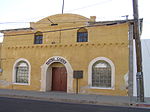South Tucson, Arizona
Arizona placenames of Native American originCities in ArizonaCities in Pima County, ArizonaEnclaves in the United StatesMexican-American culture in Arizona ... and 1 more
Populated places in the Sonoran Desert

South Tucson is a city in Pima County, Arizona, United States and an enclave of the much larger city of Tucson. South Tucson is known for being heavily influenced by Hispanic, and especially Mexican, culture; restaurants and shops which sell traditional Mexican food and other goods can be found throughout the city. According to the 2010 census, the population of the city is 5,652.
Excerpt from the Wikipedia article South Tucson, Arizona (License: CC BY-SA 3.0, Authors, Images).South Tucson, Arizona
South 6th Avenue,
Geographical coordinates (GPS) Address Phone number Nearby Places Show on map
Geographical coordinates (GPS)
| Latitude | Longitude |
|---|---|
| N 32.196111111111 ° | E -110.96888888889 ° |
Address
Sky Island Bikes
South 6th Avenue 2210
85713
Arizona, United States
Open on Google Maps







